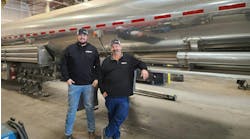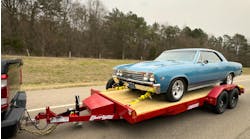The times are a-changing – and so are the trucks and trailers.
Colin Holthaus, technical director for the National Association of Trailer Manufacturers, touched on a few of the ways technology is transforming trailering during a presentation at the organization’s annual convention and trade show in Fort Worth TX, including autonomous “platooning.”
The primary goal with these trending changes is to reduce costs and increase safety.
It’s not to remove people from commercial vehicles altogether, although it often seems that way to many drivers, especially in regard to the talk of trucks flying down the freeway at 70 mph without them.
“It’s just the evolution of vehicles,” Holthaus said.
“When you have the driver taking up 25% of the cost and the fuel taking up 29% of the cost, CEO’s are always looking for efficiency, so we’ll see how that evolves.”
Autonomy
One of the most talked-about trends, along with electrification, is the movement toward self-driving vehicles.
The idea is to make roadways safer After all, cars aren’t as easily distracted as people, right KITT?
(KITT, which stands for Knight Industries Two Thousand, is David Hasselhoff’s artificially intelligent and entirely awesome Pontiac Firebird from 1980s TV show Knight Rider).
And, according to the National Safety Council, motor vehicle fatalities are on the rise, increasing 14 percent from 2014 to 2016, including 5,987 pedestrian deaths in 2016 – the most since 1990.
The estimated cost of motor-vehicle injuries, deaths and property damage was $432.5 billion in 2016.
“It’s really hard saying what the root cause of these are, but you have to think cell phones have a lot to do with it,” Holthaus said.
Still, most folks aren’t real eager to give up the steering wheel.
A 2017 AAA study revealed 78 percent of Americans are afraid to ride in a self-driving vehicle. That number dipped to 63 percent in AAA’s most recent study, but that’s still more than half the people in the United States who aren’t willing to give up control of their vehicles.
But what about autonomous tractor-trailers – with no one in the cab.
For instance, a trucking company, in theory, could send out two or three AV trucks capable of going 70 mph only 10 yards apart through WiFi connectivity, reducing fuel and driver costs.
Of course, barriers remain.
Is it really safer to have 20 tons of tractor-trailer barreling down the road without a live person in control?
And what about the roadways themselves?
As Holthaus pointed out: “Tight two-lane highways with no shoulders and steep edges are very unforgiving when it comes to accidents, so that’s another challenge as we go forward with the whole autonomous vehicle thing.”
Still, ready or not, autonomy’s on the way and, in many ways, already here.
Truck and trailer manufacturers are developing smarter systems every day, including trailer towing technology, ultrasonic sensors, radar- and lidar-equipped vehicles – and a cell phone app for all of it.
Holthaus was particularly excited about Land Rover’s invisible trailer tech, which uses multiple cameras to create a combined video feed that makes a trailer appear see-through on the rear-view mirror.
“That’s a gamechanger there,” he said.
So is Ford’s Blind Spot Information System (BLIS) trailing-towing tech, which offers trailer backup assist, cross-traffic alerts for backing up and lane-change warning lights through sensors in a truck’s tail lamps that extend a blind-spot detection system to include the trailer, whatever its length.
Toyota has the Total Safety Sense (TSS), and numerous manufacturers offer various AV sensors, including ultrasonic, which involves acoustic waves, satellite navigation, cameras and radar.
LiDAR, using infrared lasers bursts, the most accurate sensing method, but expensive.
“Long story short is you’re going to see more of them, and the quality is going to improve, but at the end of the day a customer still wants something that looks good, so they’re going to be hiding them,” Holthaus said.
Trailering trends
Another trailer trend starts with passenger trucks.
Reports from this year’s Detroit Auto Show indicate trucks sales are way up, leading to the production of more bumper-pull trailers, which are cheaper to make than the average gooseneck trailer.
Then they can be equipped with cameras, tire-pressure monitors, light controls and more – and controllable with a cell phone.
“From what I read and everything I heard, the truck was the story of this year’s Detroit auto show,” Holthaus said. “I see that being nothing but good for (trailer manufactures), because if you buy a truck for the first time, you might consider getting some hobbies and doing some trailering.”
Of course, commercial drivers still are handling the biggest trailers.
And what better way to stay safe and save money than with a fully integrated “smart” trailer – and a little bit of reflective tape.
“The vehicle is going to have a number of analytical tools … so the trailer doesn’t need to be super smart, especially if all the vehicles are able to recognize it,” Holthaus said. “But one of the things that might help the radar system cheat is if there’s some type of radar tape (on the trailer).”










